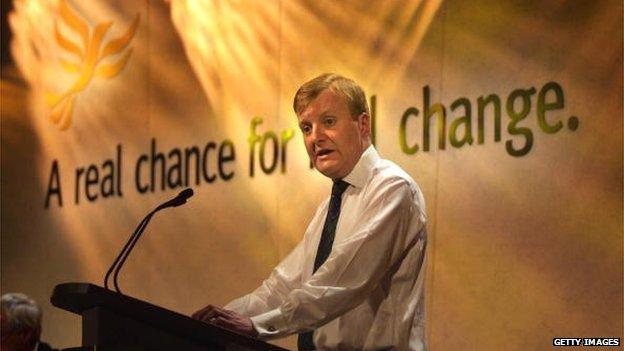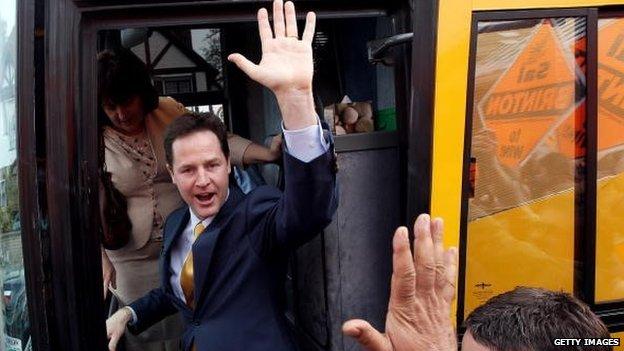Election profile: The Liberal Democrats
- Published
The Liberal Democrats will try to show they have retained their liberal principles and governed in the national interest as part of a coalition with the Conservatives.
As a philosophy, liberalism grew up around a belief in the rights of the individual and freedom of choice.
This belief underpinned the Liberal Party which emerged in the middle of the 19th Century and under William Gladstone became a major parliamentary force.
For a long period after the issue of home rule for Ireland split the party, the Liberal vote shrank and was not rebuilt until the 1950s.


David Steel was elected leader of the Liberal Party in 1976
Pavement politics
Under Jo Grimond, the Liberals began to rebuild at the grassroots, with a focus on community issues and what became known as "pavement politics".
The Liberals' popularity grew further in the 1970s under Jeremy Thorpe. By the time he resigned over accusations of an affair the party had increased support at the general election from two million to six million, gaining almost 20% of the popular vote.
After entering into the "Lib-Lab pact" and supporting Jim Callaghan's minority Labour government, the Liberals were able to form an alliance with Labour members who left to form the Social Democratic Party.
This strategy saw the two parties capture 25% of the popular vote in 1983 but did not translate into as many seats as they had hoped.
In 1988, the Liberals formally merged with the SDP, settling on the name Liberal Democrats. Under a new leader, Paddy Ashdown, the party tried to present itself as a distinctive political force, pursuing radical policies.


Charles Kennedy succeeded Paddy Ashdown as Lib Dem leader
Party of the future?
By 1997, the Lib Dems had become the second-largest party in local elections and cooperated with the Labour government in areas where they had common goals, such as devolution.
But the relationship cooled under Ashdown's successor, Charles Kennedy, and then became one of outright opposition as the Lib Dems also took a stand against the Iraq war in 2003.
The party took a dozen seats from Labour at the 2005 election but less than a year after he declared his was "the party of the future" Mr Kennedy was forced to resign as leader.
His replacement, Sir Menzies Campbell, quit in 2007 and was replaced by former MEP Nick Clegg.
As the party's poll ratings stabilised it was bolstered by the rising star of Vince Cable, who gained a reputation for sound judgement in the midst of the financial crisis.
Mr Clegg gained a personal boost when he gave a well-regarded performance in the general election televised leaders' debates of 2010, leading to an outbreak of people declaring "I agree with Nick".


Current leader Nick Clegg on the campaign trail in 2010
Risky business
Perceived popularity did not translate into as many seats as they had hoped, but it left them holding the balance of power.
When the Lib Dems entered a coalition with the Conservatives Mr Clegg acknowledged it carried "big risks".
One of the biggest risks was to the party's own reputation, which suffered a sizeable blow when Lib Dems helped to pass legislation for tuition fees - something they had pledged to oppose in their election manifesto.
For their part, the Lib Dems argue they have made a tangible difference through taking more people out of tax, increasing free childcare provision, and seeking limits on some of the government's welfare and counter-terror reforms.
They will try to drive home that message and capitalise on their strong local campaigning record at the 2015 election.